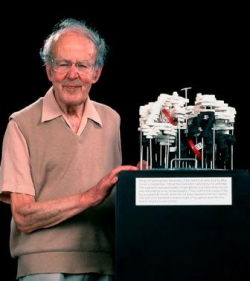Max Perutz

Max Perutz Image courtesy of MRC Laboratory of Molecular Biology
- Born
- 19 May 1914
- Died
- 6 February 2002 (age 87)
As the first scientist to establish a link between the three-dimensional structure of proteins and their function in particular disease, Max Perutz was a pioneer in structural biology and the founding father of molecular pathology.
Born in Austria in 1914, Max Perutz became interested in chemistry at school. Against his parents’ advice to study law, he decided to study chemistry at university. Through one of the lecturers, Max Perutz was introduced to John Desmond Bernal who then accepted him as a research student in his crystallography research group at the Cavendish Laboratory. Bernal encouraged Perutz to use the X-ray diffraction technique to study the structure of proteins.
It was by talking to his cousin’s husband, Felix Haurowitz, that Perutz found the target of his structural studies. He was to focus on haemoglobin, ‘the red oxygen-carrying pigment of blood’. Not only was haemoglobin easy to crystallise, but it was also known that the oxygen-bound and oxygen-free haemoglobins formed crystals with different shapes, suggesting that the molecules themselves had distinct structures. Yet no one knew what these structures looked liked.
In 1937, when Max Perutz set out to solve the structures of haemoglobin, X-ray analysis had yielded structures of molecules containing no more than 100 atoms. Haemoglobin contained more than 10,000. However, Hitler’s annexation of Austria and World War II meant that his research was put on hold for ten-years.
With the support of Lawrence Bragg in 1947 Perutz founded the Molecular Biology Unit of the Cavendish Laboratory which attracted and inspired researchers such as Francis Crick and James Watson.
In 1953, Perutz showed that the question of the structure of proteins could be solved by comparing the X-ray diffraction images of proteins alone and when bound with heavy atoms. This new methodology was a real breakthrough that revolutionised X-ray analysis, and it is still used today. Using this method, Perutz’s collaborator John Kendrew solved the structure of myoglobin in 1957.
Bragg explained that Kendrew and I were out on a treasure hunt with only the remotest chance of success but that, if we did succeed, our results would provide an insight into the workings of life on the molecular scale.
Max Perutz, explaining how Bragg convinced the Medical Research Council to fund the creation of a Molecular Biology Unit at the Cavendish Laboratory.
In 1959, 22 years after beginning the study, Perutz’s great determination paid off as he solved the first structure of haemoglobin. Max Perutz and John Kendrew were awarded the Nobel Prize in Chemistry in 1962 for their studies of the structures of globular proteins. Their very first models can still be seen at the Science Museum in London.
By comparing the structures of haemoglobin in the presence and absence of oxygen, Perutz later showed how haemoglobin works. In his own words, “haemoglobin is not just an oxygen tank: it is a molecular lung. It changes its structure every time it takes up and releases oxygen.” Perutz also showed how mutations of single amino acids in haemoglobin can change its structure and lead to diseases like sickle cell anaemia.
One hundred years after Max Perutz was born, 2014 was the International Year of Crystallography and celebrated a century of X-ray diffraction. X-ray crystallography has changed the way we look at the world around us, and has made the design of many medicines possible. To date, X-ray analysis has allowed the visualisation of the structures of around 90,000 proteins.
This page was written by a Biology: Changing the World volunteer.



